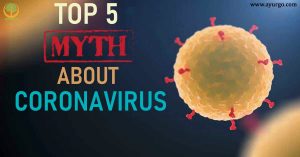Table of Contents
In this article, we will be discussing what are viruses? And where do new viruses come from?
If you’ve been watching the news, you’ve probably heard of the novel or new coronavirus which, starting in late 2019, began making people ill in china.
International air travel has since allowed it to spread person-to-person to new countries.
As the governments begin to issue travel restrictions and even quarantines, speculations about the origin of the virus began to spread online.
Some claim that the virus might be a genetically modified weapon but extraordinary claims require extraordinary evidence.
This claim currently seems highly unlikely. Others suggest that the virus may be an escaped lab specimen.
This actually is possible, viruses have escaped from research labs in the past, but as of the time I am writing this article, investigations into this idea have not yet reached any solid conclusions.
Could there be another more natural explanation for the origin of this virus?
The answer is YES, COVID-19, the new human-infecting coronavirus, may have simply evolved from an older animal-infecting coronavirus.
To understand how this may have happened let’s first take a look at viruses in general.
What are viruses?
Of the many things that can make you sick by infecting and reproducing inside you, viruses are among the smallest.
If we resize this drawing to a more realistic scale, you see that hundreds of viruses can fit inside a single bacterial cell, that’s how tiny they are.
Thousands of different viral species have been studied and described by scientists so far, millions more likely exist.
They come in many forms but all species consist of a small collection of genes (stretches of either DNA or RNA that carry information for making more copies of the virus) and those genes are enclosed in a protective coating of protein and sometimes a lipid membrane.
All known viruses are parasitic, but most are not parasitic to humans. Instead some only target plant cells; others only infect bacteria and so on.
A virus reproduces by giving its genes into a living cell. Different viruses do this in different ways, but once inside, the cell acts as if the viral genes were its own genes.
It begins reading them and making copies of the virus instead of performing its fundamental tasks.
Coronaviruses are a huge family of virus species that infect animal cells, some infect chickens, others infect pigs, some infect humans but most of them are extremely mild, this simply gives you the common cold.
“CORONA” means Crown and refers to the large crown-like spikes sticking out of their membranes.
These protein spikes are selectively sticky, sort of like VELCRO.
They don’t attach to most objects but are extremely sticky when they bump into specific molecules found on the outsides of the animal cells.
Once held firmly in place, the coronavirus waits until swallowed by the cell. It then begins to reproduce at the expense of the cells.
Different animal species have different types of molecules on the outsides of their cells.
Because of this, birds infecting coronaviruses usually can’t infect humans, their VELCRO doesn’t hold strong enough to our cells.
Unfortunately, the natural process of evolution can sometimes help a virus overcome this problem.
Where do new Viruses come from?

When virus genes are being copied during reproduction, mutations can occur. These are either due to simple copying errors, or processes called re-assortment and re-combination.
These happen when two or more viruses infect a single cell. In most cases, mutations that change the shape of viral spikes leave the virus useless.
There Velcro no longer sticks to any host cells.
Sometimes, a chance mutation will just happen to allow a virus to attach to a new host species.
If the modified virus is then lucky enough to enter that new host species, an infection can occur.
We call this a “spillover infection”. The virus is spilled over into a new type of host.
Early on during a spill-over event, the virus usually isn’t very good at infecting its new host.
Its Velcro is not a perfect match and many other challenges might slow the virus down.
Oftentimes the mutations that let it infect the new host also make it worse at infecting its original host.
Because of this, many spillover viruses go extinct after infecting just one or two people.
That said, if the virus can survive and reproduce just enough, natural selection will promote any new mutations that help it better spread and reproduce in the new host population.
Positive mutations accumulate over multiple generations; negative mutations are discarded until a new epidemic is being screamed about on the news.
Though it may seem to us that these new viruses just sort of pop into existence overnight, scientists now know there is a long slow burn before each explosion.
You may also like: What is the difference between a VIRUS and BACTERIA?
History of some Viruses
Genetic evidence tells us that slowly evolving spillovers have been a cause of almost every major outbreak known in history.
In the early 2000s, a coronavirus that used to only infect bats appears to have spilled over into civets.
There it mutated even further and spilled over into humans. We called it the SARS virus because it causes Severe Acute Respiratory Syndrome.
It spread internationally from person to person, and several scientists were infected in the lab.
By the time the virus was contained, over 8000 people had been infected, over 700 died.
A coronavirus from camels also recently spilled over to humans causing even more deaths.
Coronaviruses are not the only types of animal viruses that can adapt to new hosts.
HIV spilled over from chimps, most likely when someone cut themselves while preparing chimp meat for dinner.
The swine flu came partly from pigs, but we think it actually evolved through recombination with a pig virus and a bird virus.
The 1918 Spanish Flu, the big one that devastated populations all around the world have spilled over from chickens, while the evidence is not yet conclusive, the new coronavirus might just be one more example of normal evolution.
A very similar virus has been found in bats and another was recently discovered in pangolins. These animals are endangered; they’re protected, but often used illegally for food, rituals, and alternative medicine in the region where COVID-19 first broke out.
Can a Virus be Man-Made?

Now, there are many serious people who are checking to make sure that the virus did not come from a laboratory, either by accident or on purpose.
After all, the technology to genetically modified viruses really does exist, but it’s important to understand that the normal process of descent with modification acted upon by natural selection really does produce new viruses. It happens naturally.
The chance of a virus evolving to successfully infect a new species is extremely low but there are over seven and half billion people on this planet, most of us interact with animals on a daily basis.
We keep them as pets, we eat them as food. This means that as unlikely as spillover infections might be, there are billions of opportunities for one to take hold every single day.
Add this fact that the entire world is now connected through international flights, and you realize that what happens in Vegas doesn’t actually stay in Vegas, at least not the way that it is used to.
Luckily we have international groups like the World Health Organization and various centers for Disease Control to help contain outbreaks when they happen.
With international cooperation, we have prevented many catastrophes in the past and we will prevent many more in the future so long as our species continues to work together.
Quick Summary
In most of the cases, new viruses evolve from old viruses. Stopping the spread of new viruses requires international cooperation.
For up-to-date, accurate information on the risks, visit the World Health Organization website.
If you are still reading, I believe you must have understood What are viruses and how they evolved. Please share it with your friends directly from the social icons below.






